POSTTEST
Science
This Science Posttest is designed to help you determine how well you have mastered this GED® test subject area and whether you are ready to take the real GED Science test.
This test has 40 items. The questions are in the same formats as the ones on the real exam and are designed to measure the same skills. Many of the questions are based on short reading passages on science topics. Some are based on scientific illustrations, diagrams, or other graphics. Most of the questions are in multiple-choice format, but you will also see questions that ask you to draw a line or indicate a point on a diagram, fill in a blank, or write a short answer. On the real GED® test, you will indicate your answers by clicking on the computer screen. For this paper-and-pencil practice test, mark your answers directly on the page. Write your short-answer responses on a separate sheet of paper. You may use a calculator.
To get a good idea of how you will do on the real exam, take this test under actual exam conditions. Complete the test in one session and follow the given time limit. If you do not complete the test in the time allowed, you will know that you need to work on improving your pacing.
Try to answer as many questions as you can. There is no penalty for wrong answers, so guess if you have to. In multiple-choice questions, if you can eliminate one or more answer choices, you can increase your chances of guessing correctly.
After you have finished the test, check your answers in the Answers and Explanations section that follows the posttest. Then use the Evaluation Chart at the end of the Answers and Explanations section to determine the skills and content areas in which you need more practice.
Now turn the page and begin the Science Posttest.
POSTTEST
Science
40 questions  90 minutes
90 minutes
Use the following passage for Items 1 through 3:
Respiratory homeostasis involves regulating the amount of oxygen and carbon dioxide in the blood. The exchange of gases takes place between the alveolar sacs in the lungs and the capillaries.
Blood leaving the lungs in the capillaries will have partial pressures of oxygen and carbon dioxide in amounts that are similar to the average values found in the alveoli. If the amount of carbon dioxide in the blood is different from the amount in the alveoli, chemical receptors detect the change and alert the respiratory system to respond.
1. Which of these responses best indicates high levels of carbon dioxide in blood?
A. fever
B. coughing
C. rapid breathing
D. excessive urination
Use the following diagram for Item 2:
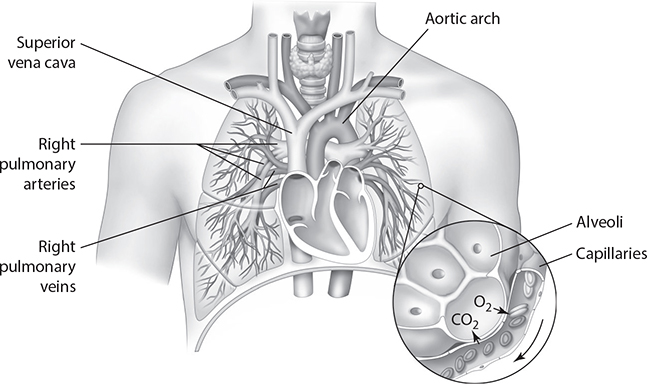
2. Using the information in the passage, identify and mark an X on the location of the exchange of gases.
3. Based on the information in the passage, the respiratory, cardiovascular, and nervous systems work together to regulate
A. capillary action.
B. ventilation pathways.
C. blood gas composition.
D. chemical receptor functions.
Use the following passage and diagram for Item 4:
During flu season, proper hand hygiene is the best way to reduce the spread of infection. Some viruses can live up to eight hours on surfaces made of plastic and metal. Viruses can be transmitted when students rub eyes and noses and then touch a surface. Examine the elementary-classroom map in the following diagram.
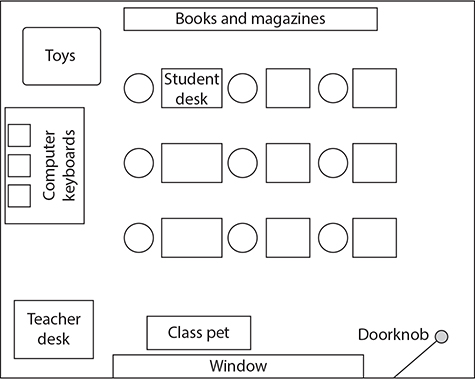
4. Identify the three surfaces that should be cleaned most frequently to reduce the spread of viruses to students by marking an X on three labeled locations on the map.
Use the following passage and diagram for Items 5 through 7:
Energy and nutrients pass through the trophic levels of an ecosystem when organisms feed on one another. The following image shows a terrestrial food chain common in a variety of ecosystems. The arrows show the flow of energy from one organism to the next.

Not pictured in the image are detritivores, often called decomposers. Detritivores are important components of every ecosystem. These organisms derive energy from organic wastes, such as fallen leaves and the remains of dead organisms from other feeding levels. The organic material that composes living things is eventually recycled and returned to the nonliving environment in forms that can be used by plants.
5. The flower in the terrestrial food chain obtains energy for life functions from the process of
A. acidification.
B. fermentation.
C. photosynthesis.
D. chemosynthesis.
6. On the following diagram, draw lines to match each organism with its correct role in the food chain.
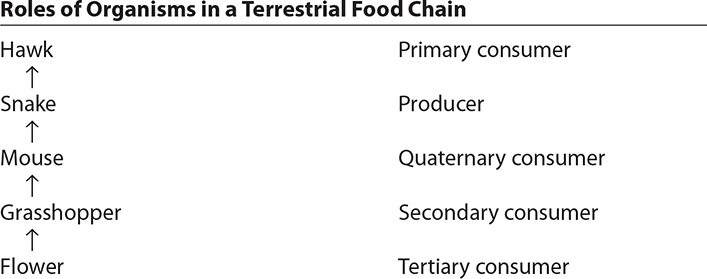
7. Short answer
Consider the role of detritivores in the ecosystem. What effect would a decline in the detritivore community have on this particular terrestrial food chain? Include multiple pieces of evidence from the text to support your answer.
Write your response in the space provided. This task may take approximately 10 minutes to complete.

Use the following passage for Items 8 through 10:
Jane wants to feed her family healthy, nutritious, and organic food without spending a lot of money. She decides to plant her own garden to accomplish these goals. Next to her garden, she builds a cistern to collect rainwater for the plants. For plant health, Jane opts to use beneficial lady beetles, more commonly called ladybugs, to control pests in the garden.
Jane learns that ladybugs are the natural enemies of garden pests such as aphids, mealy bugs, and leafhoppers. Ladybugs benefit plants in a number of ways. While they prefer to feed on aphids, they also eat other foods such as pollen and nectar, acting as pollinators. Jane also stays alert for signs of ant colonies. Ants that feed on the products of aphids can attack and drive off ladybugs, leaving a garden undefended.
8. Which of the following could directly lead to an increase in the ladybug population?
A. stabilized ant colony
B. growing aphid population
C. increased honeybee activity
D. declining leafhopper population
9. What type of symbiotic relationship is seen when ladybugs fill the role of plant pollinators?
A. parasitism
B. mutualism
C. amensalism
D. commensalism
10. Jane’s garden acts as a small ecosystem composed of both living and nonliving factors. Which of the following incidents could cause a severe imbalance in this environment?
A. extended drought
B. pesticides in rain runoff
C. addition of composted soil
D. genetically modified seeds
Use the following passage for Items 11 through 13:
Metabolism is the process of converting the calories in food and beverages into energy. The number of calories a body needs to carry out the basic functions of life is called the basal metabolic rate, and it accounts for 60 to 75 percent of the calories burned every day. Several factors determine an individual’s basal metabolic rate.
• Body size and composition: The bodies of people who are larger or who have more muscle burn more calories, even at rest.
• Gender: Men usually have less body fat and more muscle than women of the same age and weight, burning more calories.
• Age: As people age, the amount of muscle tends to decrease and fat accounts for more of the weight, slowing down calorie burning and lowering the basal metabolic rate.
11. According to the passage, which of the people described below would have the highest basal metabolic rate?
A. male, age 25, 6.2 feet tall, muscular
B. female, age 20, 5.4 feet tall, muscular
C. male, age 45, 6.5 feet tall, overweight
D. female, age 75, 5 feet tall, overweight
12. Which statement best explains why people with more muscle have a higher metabolism?
A. Muscle tissues are organized into three types, cardiac, skeletal, and smooth muscles.
B. Muscle cells contain more mitochondria, the cellular organelles that produce energy.
C. Muscle tissues can work without conscious thought, such as involuntary heart muscles.
D. Muscle cells contain protein filaments that slide past one another, causing contractions.
13. When the calories in food are converted to energy for muscle movement, what type of transformation takes place?
A. chemical to kinetic
B. kinetic to chemical
C. kinetic to mechanical
D. mechanical to chemical
Use the following passage and chart for Item 14:
Hemophilia is a bleeding disorder in which blood does not clot normally. Queen Victoria of England was a carrier of this rare genetic disorder. Examine the Queen’s pedigree chart.
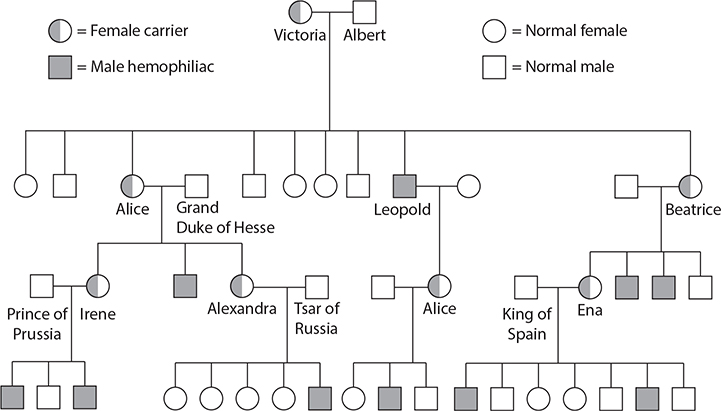
14. Using the information in the chart, write the appropriate number answer in the blank.
Queen Victoria had ___________________ daughters who were known to have carried the gene for hemophilia.
Use the following passage and diagram for Item 15:
There are two patterns of speciation. The first, called anagenesis, takes place when a single population is transformed enough to be called a new species. The second, called cladogenesis, is the budding of one or more new species from a parent species that continues to exist.
Examine the birds in the following diagram.
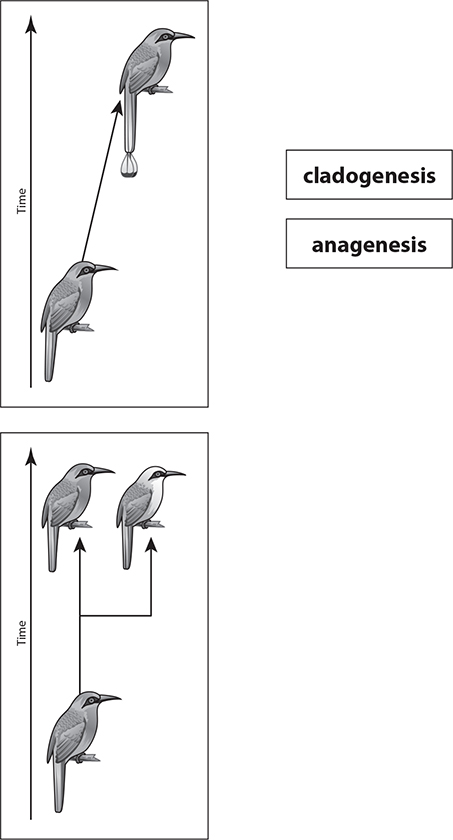
15. Draw a line to connect the correct word with the set of birds that best illustrates the definition.
Use the following diagram for Item 16:
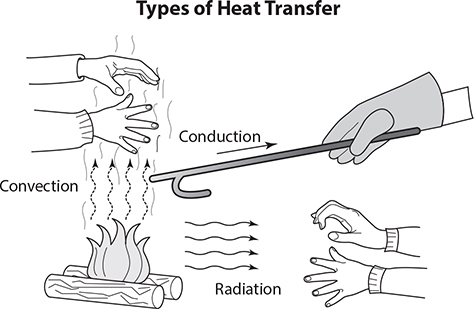
16. Based on the information from the picture, write the appropriate term in the blank.
In the process of ___________________, heat is transferred from one particle of matter to another in an object without the movement of the object itself.
Use the following definitions and cartoon for Item 17:
Exothermic reaction: a type of reaction that gives out energy in the form of heat
Endothermic reaction: a type of reaction that takes energy from the surroundings
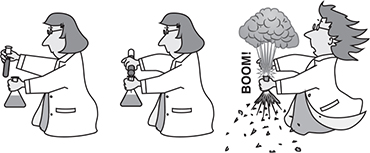
17. Based on the given information, write the appropriate answer in the blank.
The reaction shown in the cartoon is a type of ___________________ reaction.
Use the following pie chart for Item 18:
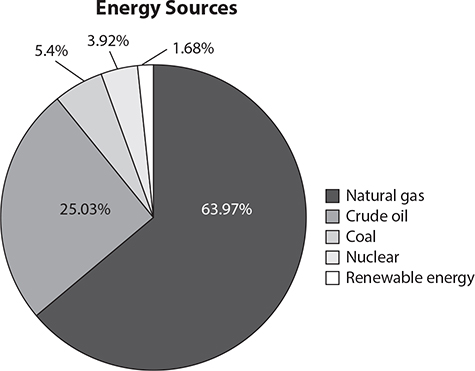
18. Approximately what percentage of total energy comes from renewable energy?
A. 2%
B. 4%
C. 5%
D. 25%
Use the following diagram for Item 19:
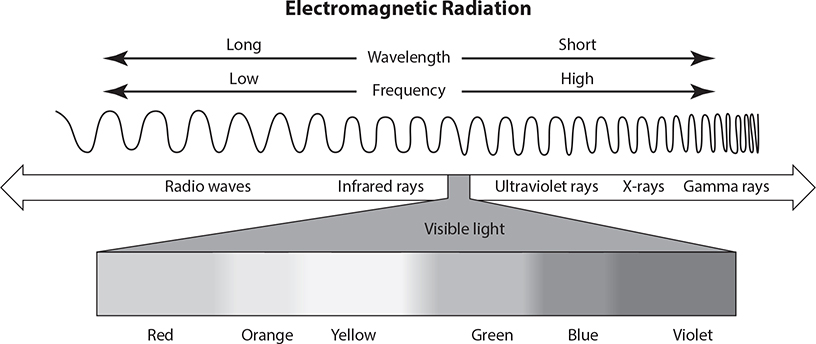
19. Based on the information from the diagram, write the appropriate answer in the blank.
___________________ have the shortest wavelengths and the highest frequencies.
Use the following cartoon for Item 20:
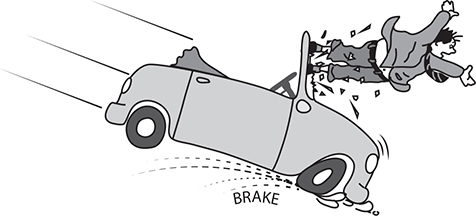
20. Which of the following principles of motion is NOT illustrated in this cartoon?
A. unbalanced force, because there is no seat belt
B. constant acceleration, because the velocity may vary
C. inertia, because the car is at rest and the driver is moving
D. transfer of momentum, because the driver and car have mass and velocity
Use the following diagram for Item 21:
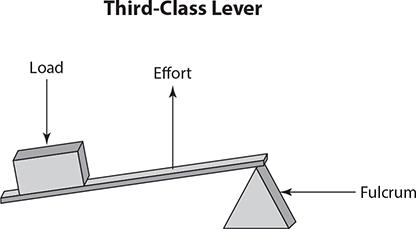
21. Which of these objects would best be classified as a third-class lever?
A. seesaw
B. scissors
C. hammer
D. wheelbarrow
Use the following graphic for Item 22:
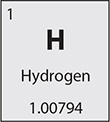
22. How many protons are found in the nucleus of a hydrogen atom?
A. 1
B. 1.007
C. 2.008
D. 3
Use the following passage for Item 23:
A chlorine atom has seven electrons in its outer shell. It can reach a full outer shell by gaining 1 electron. It will then become the chloride ion, Cl−.
23. When an atom, such as Cl−, has a negative charge, it contains
A. one more electron than neutrons.
B. one more electron than protons.
C. many more protons than electrons.
D. many more electrons than neutrons.
Use the following chart for Items 24 through 25:
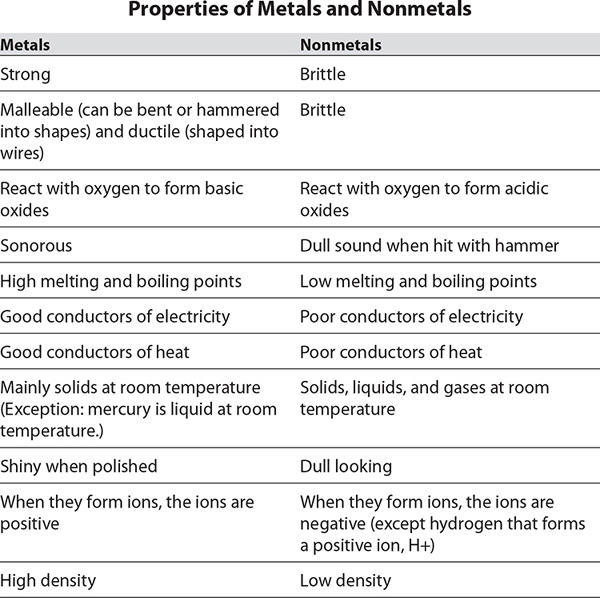
24. How would a colorless, odorless gas with a very low melting point and a high density at the boiling point best be classified?
A. as a metal because it has a high density
B. as a metal because it has a boiling point
C. as a nonmetal because it is a colorless gas
D. as a nonmetal because it has a melting point
25. Short answer
Consider a copper penny. Using the information in the preceding chart, discuss the properties of the element copper that make it a good choice for jewelry, cookware, and electrical wiring. Include multiple pieces of evidence from the chart to support your answer.
Write your response in the space provided. This task may take approximately 10 minutes to complete.

26. Which chemical equation correctly illustrates the following statement?
Magnesium burns in oxygen to produce magnesium oxide.
A. O2 + MgO → 2Mg
B. 2Mg + O2 → 2MgO
C. 2MgO + O2 → 2Mg
D. 2O2 + 2Mg → 4O + 2Mg
Use the following illustration for Item 27:
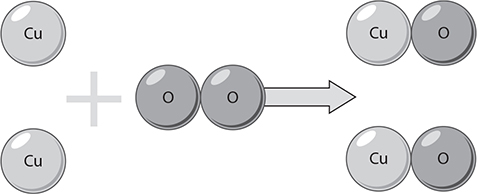
27. Which equation is represented by the symbols shown?
A. 2Cu + O2 → 2CuO
B. 2Cu + 2O → CuO2
C. 2Cu + 2O2 → 2CuO2
D. Cu + 2O → Cu2O2
Use the following passage for Item 28:
The measure of the concentration of hydrogen ions in a solution is called pH. The lower the pH, the higher the concentration of hydrogen ions in the solution. Measured pH values range from 0 to 14. Strong acids, such as hydrochloric acid, have a pH around 0 to 1. A solution of a strong alkali, such as sodium hydroxide, has a pH of 14.
28. What could be inferred about a substance with a pH of 7?
A. It is mildly acidic.
B. It is a strong alkali.
C. It is slightly alkaline, not acidic.
D. It is neither acidic nor alkaline.
Use the following passage for Items 29 through 31:
Scientists can often tell where crude oil is trapped by looking at the shape and structure of rocks. Oil tends to be located where permeable rocks are in contact with impermeable rocks at a fault line or where impermeable rocks are domed upward.
Crude oil formation began millions of years ago when microscopic ocean plants and animals died. The remains were covered by many layers of sediment that eventually turned to rock. As temperature and pressure increased, the organic remains slowly changed into crude oil. That oil is extracted by drilling through the impermeable rocks.
There are several concerns about the world population’s dependence upon oil. Unless oil is used more efficiently, supplies of crude oil could run out in the next 30 years. Additionally, when oil is burned, it gives off carbon dioxide. The increase of carbon dioxide in the atmosphere contributes to global warming and ocean acidification.
29. Based on the passage, which statement best summarizes the locations of crude oil?
A. Permeable rocks, found underground, trap crude oil inside rocky domes.
B. Oil is usually located inside impermeable rocks underneath the ocean floor.
C. Crude oil is found trapped in some of the sedimentary rocks of Earth’s crust.
D. In areas of high temperature, dome-shaped rocks near fault lines house most of the oil.
30. According to the passage, oil supplies may be depleted within the next 30 years. Which statement supports this concern?
A. Locating oil underground is imprecise.
B. Formation of oil takes millions of years.
C. Burning oil contributes to global warming.
D. Drilling for oil is time consuming and expensive.
31. Based on the information in the passage, in what way does crude oil contribute to climate change?
A. by increasing acidification of ocean water
B. by raising air temperature from burning oil
C. by adding carbon dioxide to the atmosphere
D. by decreasing the oil reserves in Earth’s crust
32. In extreme weather events, strong winds can turn stationary objects into dangerous projectiles. A safe room is a specially designed, hardened, windowless structure inside a home. It is meant to provide protection from flying debris. A home with an underground safe room would best protect a person from which type of natural hazard?
A. tornado with hail
B. wildfire with smoke
C. hurricane with flooding
D. earthquake with aftershocks
Use the following passage and illustration for Item 33:
Rip currents are narrow, fast-moving belts of water caused by circulation cells. They flow seaward from near the shore. Rip current speeds are typically 1 to 2 feet per second, and they can sweep even the strongest swimmer out to sea.

33. A swimmer can best escape a rip current by
A. standing still in the water.
B. swimming parallel to the beach.
C. floating in between the wave breaks.
D. trying to swim perpendicular to the shoreline.
Use the following passage and illustration for Item 34:
The image illustrates the Coriolis effect. The solid lines on the globe represent the path wind would take if it were not influenced by the Coriolis effect. The dotted lines represent the actual path of wind, as viewed from the equator.
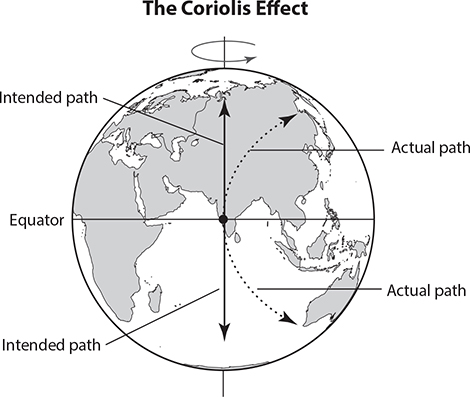
34. Based on the image above, which of these statements best explains why wind does not blow in a straight line?
A. Earth rotates at a high speed clockwise as viewed from the North Pole.
B. Earth’s counterclockwise spin causes the illusion of wind traveling in a curved path.
C. Wind traveling over land in the Southern Hemisphere creates areas of high pressure.
D. The spin of Earth causes winds in the Northern Hemisphere to curve to the right.
Use the passage and pictures for Item 35:
The gravitational pull of the sun and the moon influence the tides on Earth. When the moon is in line with the sun, the gravitational pull from the two objects combines. The combined gravitational pull produces extra high and extra low tides twice a month. These types of tides are referred to as spring tides.

35. Which pictures show the proper conditions to produce a spring tide?
A. 1 and 2
B. 2 and 3
C. 3 and 4
D. 4 and 1
36. A Punnett square cross yields 50% heterozygous traits (Tt) and 50% homozygous recessive traits (tt). Which were the MOST likely genotypes of the parents crossed?
A. TT × tt
B. Tt × Tt
C. tt × tt
D. Tt × tt
37. Which of the following materials would be a good conductor?
A. a vinyl floor because it does not transfer heat
B. a plastic spoon because it does not absorb heat
C. a wool blanket because it slows the transfer of heat from skin
D. a copper pipe because it accelerates the transfer of heated materials
Use the following passage and table to answer Item 38:
Four substances (A–D) were introduced into a laboratory-based aquatic food chain consisting of producers, primary consumers, and secondary consumers. Samples were taken from each trophic level, and the concentration of each substance was measured in the tissues. The data are shown in the table.
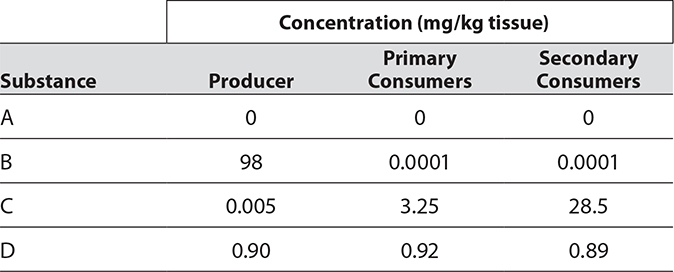
38. Which explains the results of substance B?
A. Each subsequent trophic level accumulated substance B, but could not metabolize it.
B. Substance B was accumulated by producers, but either excreted or metabolized by consumers.
C. Substance B could not be absorbed by either producers or consumers.
D. Substance B was not taken up by producers and therefore not passed up the food chain.
39. Which is MOST specialized with respect to biological organization?
A. red blood cell
B. skeletal muscle
C. circulatory system
D. lung
Use the following passage and table to answer Item 40:
Bacterial cells were exposed to four different substances (A–D). The effects of each substance on levels of various biologically important molecules are shown in the table.
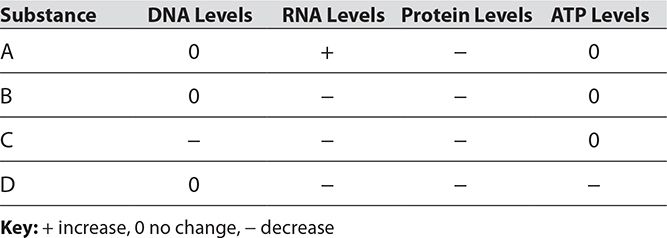
40. Which process was likely affected by substance A?
A. DNA replication
B. transcription
C. translation
D. ATP synthesis
THIS IS THE END OF THE SCIENCE POSTTEST.
Answers and Explanations
1. Correct answer: C. The values for blood gas composition are established by the amounts of carbon dioxide and oxygen in the alveoli. If blood gas composition, especially carbon dioxide level, moves outside of the homeostatic range, alveolar ventilation will increase. This results in increased respiration, breathing in and out faster, to expel carbon dioxide from the lungs more efficiently.
2. Correct answer: The X should be at the site where the alveoli and capillaries come into contact with one another.
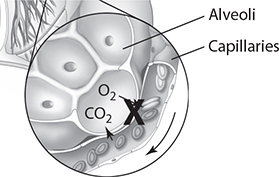
Oxygen and carbon dioxide are exchanged through the semipermeable membranes of the alveolar sacs and capillaries. Oxygen is inhaled, is transported through the respiratory system, and enters the blood. Carbon dioxide in the blood moves into the respiratory tract and is exhaled.
3. Correct answer: C. Chemoreceptors, part of the nervous system, detect changes in blood gas composition, especially of carbon dioxide, that move outside the homeostatic range. These receptors dictate an exchange between the respiratory and cardiovascular systems via the lung-capillary exchange barrier.
4. Correct answers: The doorknob, computer keyboards, and toys should be marked with an X.
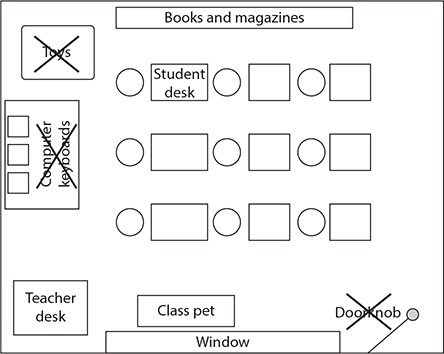
These surfaces are the most likely to be handled by every member of the class. Doorknobs, computer keyboards, and toys are also composed primarily of plastics and metals, surfaces that harbor viruses for a long time.
5. Correct answer: C. The flower in the terrestrial food chain is a primary producer. It is a photosynthetic organism that uses light energy to synthesize sugars and other organic compounds, which are then used as fuel for cellular respiration and growth.
6. Correct answer: The flower is a producer, the grasshopper is a primary consumer, the mouse is a secondary consumer, the snake is a tertiary consumer, and the hawk is the quaternary consumer. A producer is always the base of a food chain and is followed by successive levels of consumers.

7. Response contains:
3-Point Response
• A clear and well-developed explanation of how a decline in the number of detritivores impacts the terrestrial food chain
• Complete support from the passage
Sample Paper
A decline in the detritivore community could lead to less nutritious soil. Organic waste, such as fallen leaves, contains important nutrients. If the number of decomposers were to drop, this waste might not be decomposed and added back to the Earth, resulting in poor soil for the flowers eaten by the grasshoppers. This could lead to a decline in grasshoppers that would impact each additional animal in the terrestrial food chain. The energy left in dead organisms would also not be accessible to the rest of the food chain because it would not be recycled by detritivores and returned to the nonliving community.
2-Point Response
• An adequate or partially articulated explanation of how a decline in the number of detritivores impacts the terrestrial food chain
• Partial support from the passage
Sample Paper
If decomposers began to decline, organic waste would not be broken down. Plants, such as the flowers in the terrestrial food chain, need good soil to grow, and detritivores recycle nutrients into the soil. Other animals in the food chain might decline if the flowers cannot grow in poor soil.
1-Point Response
• A minimal or implied explanation of how a decline in the number of detritivores impacts the terrestrial food chain
• Minimal or implied support from the passage
Sample Paper
Without decomposers, waste would not break down. Flowers could not grow well and the grasshoppers might die.
0-Point Response
• No explanation of how a decline in the number of detritivores impacts the terrestrial food chain
• No support from the passage
8. Correct answer: B. Ladybugs require food for themselves and their young in order for their population to thrive. An important way to encourage an increase in ladybug population growth is to have an abundant source of aphids for them to feed on.
9. Correct answer: B. The plant and ladybug enjoy a mutualistic relationship. Ladybugs help the plant propagate by pollinating, and the ladybug receives nutrition from the nectar and pollen. The plant also serves as a host home for the ladybug as well as aphids. The ladybug eats the aphids, which are plant parasites, thus benefiting the plant. The plant benefits when the parasitic aphids are removed.
10. Correct answer: A. Jane’s garden ecosystem would be severely impacted by an extended drought. The rain cistern that she uses to water her plants would dry up without rainfall. Without a steady source of water, the plants would wither, failing to support the insect populations.
11. Correct answer: A. Young males, with more muscle and a bigger body size and composition, will burn more calories than young or older females and older males, resulting in a higher basal metabolic rate.
12. Correct answer: B. Muscular activity accounts for much of the body’s energy consumption. All cells produce adenosine triphosphate (ATP) molecules inside mitochondria. Muscle cells have more mitochondria than any other type of cell, which allows them to respond quickly to the need for doing work.
13. Correct answer: A. When calories in food are consumed, the chemical energy held in the sugars is converted in the mitochondria of muscle cells into the kinetic energy of motion.
14. Correct answer: two. Of the six daughters born to Queen Victoria, two are denoted on the pedigree chart as being female carriers of the hemophilia gene. Females are denoted with a circle and a carrier female has half of the circle shaded. Alice and Beatrice are designated with half-shaded circles as carrier females.
15. Correct answer: anagenesis, cladogenesis. The illustration on the left showing two birds and a single arrow is an example of anagenesis. The arrow points to a new species of bird, denoted by the color change and modified tail feathers. The illustration on the right showing a branching of arrows is cladogenesis, a type of branching evolution. The originating species still exists, and a new species is also depicted.
16. Correct answer: conduction. Conduction is the transfer of thermal energy through direct contact between particles of matter. The picture shows heat from the fire traveling along a metal rod to a person’s hand.
17. Correct answer: exothermic. Specifically, the reaction shown is a combustion reaction, a type of exothermic reaction, shown by the explosion. The scientist in the cartoon added an oxidizer to a combustible material that reacted to form an oxidized product and release heat.
18. Correct answer: A. The graph attributes 1.68%, rounded to 2%, to renewable energy sources. (Wind power is considered a sustainable energy source and would be classified as renewable on this graph.)
19. Correct answer: Gamma rays. Gamma rays are the most penetrating of all the electromagnetic waves and have the greatest amount of energy. These types of waves have the highest frequencies and the shortest wavelengths, and they are used in radiation therapy to kill cancer cells.
20. Correct answer: B. Acceleration is the rate of change of velocity. Sometimes an accelerating object will change its velocity by the same amount each second; this is referred to as constant acceleration. A steady change in velocity over time is not clearly illustrated in this image.
21. Correct answer: C. A hammer acts as a third-class lever when it is used to drive in a nail. The fulcrum is the wrist at one end of the hammer. The effort is applied through the hand, and the load is the resistance of the surface the nail is piercing at the other end of the hammer.
22. Correct answer: A. The atomic number of an element indicates the number of protons in the nucleus of an atom of that particular element. Hydrogen has 1 proton. The periodic table of elements organizes elements by the atomic number, denoted in the upper left corner of the box representing hydrogen.
23. Correct answer: B. The designation of Cl− signifies that the ion contains one more electron than the number of protons. An ion is a charged particle, charged due to an unequal number of electrons and protons.
24. Correct answer: C. This element best fits the characteristics of a nonmetal because it is a gas. Metals are usually solids at room temperature, with the exception of mercury, which is a liquid.
25. Response contains:
3-Point Response
• A clear and well-developed explanation of the properties of copper useful for jewelry making, cookware, and electrical wiring
• Complete support from the chart
Sample Paper
Copper is a metal that has a hard and shiny appearance. It is strong and malleable, which are good properties for jewelry. It is strong, malleable, and a good conductor of heat, which make it a good material for cookware like pots and pans. The ductility of copper and its ability to conduct electricity well make it a good choice for electrical wiring.
2-Point Response
• An adequate or partially articulated explanation of the properties of copper useful for jewelry making, cookware, and electrical wiring
• Partial support from the chart
Sample Paper
A metal like copper is good for jewelry because it is shiny and easy to shape into rings and necklaces. Copper is good for pots and pans because it is a good conductor of heat. It is good for electrical wiring because it can be made into wires.
1-Point Response
• A minimal or implied explanation of the properties of copper useful for jewelry making, cookware, and electrical wiring
• Minimal or implied support from the chart
Sample Paper
Copper is shiny, so it is a good choice for jewelry. It can also be used in pots and pans and wires because it is strong.
0-point response
• No explanation of the properties of copper useful for jewelry making, cookware, and electrical wiring
• No support from the chart
26. Correct answer: B. Magnesium oxide is the product, so it is written on the right side of the equation. Oxygen and magnesium are the reactants and are therefore located on the left side of the equation. Because oxygen has 2 atoms, MgO must be multiplied by 2 so that there are 2 oxygen atoms on the product side of the equation. This creates 2 magnesium atoms on the right, so magnesium is multiplied by 2 on the left side to balance the overall equation.
27. Correct answer: A. Two atoms of copper react with two atoms of oxygen to form two molecules of copper oxide. This results in two copper atoms and two oxygen atoms shown on each side. 2Cu + O2 → 2CuO. The numbers in front of the formulas are coefficients, indicating the relative number of molecules or ions of each kind involved in the reaction. Numbers to the lower right of chemical symbols in a formula are subscripts, indicating the specific number of atoms of the element found in the substance. Coefficients and subscripts of 1 are never written; they are understood.
28. Correct answer: D. A substance with a pH of 7 falls in the middle of the pH range. It is neither acidic, between 0 and 7, nor alkaline, between 7 and 14. It is a neutral substance, such as distilled water.
29. Correct answer: C. Crude oil is found trapped in sedimentary rock layers. Over millions of years, organic matter undergoes high pressures and temperatures and is compressed under layers of permeable and impermeable sediment. The organic matter changes into oil and is trapped between permeable and impermeable layers below Earth’s crust.
30. Correct answer: B. Crude oil takes millions of years to form and is being depleted more quickly than it is created. Present estimates suggest that world supplies of crude oil will run out in about 30 years unless the oil is used more efficiently.
31. Correct answer: C. Photosynthesis by plants and algae uses carbon dioxide from the atmosphere. However, the burning of fossil fuels (coal and oil) is adding carbon dioxide to the atmosphere faster than it can be removed. This means that the level of carbon dioxide in the atmosphere is increasing, contributing to global warming.
32. Correct answer: A. A safe room below ground would best protect a person from the flying debris blown about in tornadic force winds. A hardened structure without windows would also protect against any hail. Because the structure is below ground, it could be subjected to flooding, making it not ideal for occupants in flood zones or the path of a storm surge.
33. Correct answer: B. In the image, the escape route is marked by arrows parallel to the shoreline. A person is able to move out of the seaward current by swimming alongside the shoreline in a parallel manner, as depicted in the image.
34. Correct answer: D. The Coriolis effect describes the turn of the wind to the right in the Northern Hemisphere that is caused by Earth’s rotation. It does not impact the wind speed, only the wind direction. In the Northern Hemisphere, the spin of Earth causes winds to curve to the right; the winds curve to the left in the Southern Hemisphere.
35. Correct answer: A. Spring tides occur at the full moon and the new moon each month. The sun and moon together produce extra high and extra low tides because they are in line and their gravitational pull is added together. When the sun and moon are at right angles, the sun’s pull is subtracted from the moon’s and the variation in tides is less, resulting in neap tides.
36. Correct answer: D. Tt × tt will yield 50% Tt and 50% tt. You can verify this by making a Punnett Square for this cross.
37. Correct answer: D. A copper pipe is an excellent conductor of heat and electricity. The materials in the other choices are good insulators.
38. Correct answer: B. The appearance of substance B in producers indicates that they could absorb substance B and accumulate it in their tissues. However, the absence of substance B in consumers indicates that they could either excrete or metabolize substance B.
39. Correct answer: C. With respect to biological organization: cells < tissue < organ < organ system. So the circulatory system is the most specialized.
40. Correct answer: C. In the hormone-stimulated cells, substance A causes no change in DNA or ATP levels, so it does not alter DNA replication or ATP synthesis. However, the increase in RNA and subsequent decrease in protein levels indicate that RNA is being made, but not translated into protein. So, translation is the most likely process affected by substance A.
Evaluation Chart
Check the Answers and Explanations section of the Science Posttest to see which answers you got correct and which ones you missed. For each question that you missed, find the item number in the following chart. Check the column on the left to see the test content area for that item. If you missed questions in a particular content area, you need to pay particular attention to that area as you study for the GED® test. The pages of this book that cover that content area are listed in the column on the right.
